Current location: Home > NEWS > Industry news
NEWS
PRODUCTS
90% women have misconceptions about breast cancer screening. Prevention and treatment of "breast cancer" from standardized screening (Ⅰ)
News source: Release time:[2024-09-29]
Breast cancer-a famous "beauty killer", let a person fearsome! According to the latest global cancer burden data from the International Agency for Research on Cancer (IARC), breast cancer ranks first in morbidity and fifth in mortality among women in China [1]. This data looks really scary at first sight, and it really threatens women's health. So it can only be left "far ahead" and helpless? In fact, it is not the case. All walks of life in the society are struggling against it. With the increasing awareness of cancer prevention, the development of popular science and education work on breast cancer, and the operation of screening project for two cancers (cervical cancer and breast cancer), the early diagnosis rate of breast cancer has increased year by year. Diversified treatments are turning the management and treatment of breast cancer as a chronic disease into a reality, thus reducing the mortality rate of breast cancer. Among them, breast cancer screening is an important part, which can improve the cure rate of breast cancer and reduce the mortality of breast cancer by more than 20% [2].
01. Screening classification [3]
Breast cancer screening
Group screening
Organized by government departments, organized and planned breast cancer screening is available for all women of appropriate age. (The national "two cancer screening" project, but there are restrictions on people participating in the screening conditions)
Opportunistic screening
Women of appropriate age or individual women who visit a medical institution for various reasons voluntarily go to the medical institution for breast cancer screening.
(currently the main form of breast cancer screening in China)
02. Screening population [4]
High-risk population
• Pre-screening is required < 40 years but ≥25 years
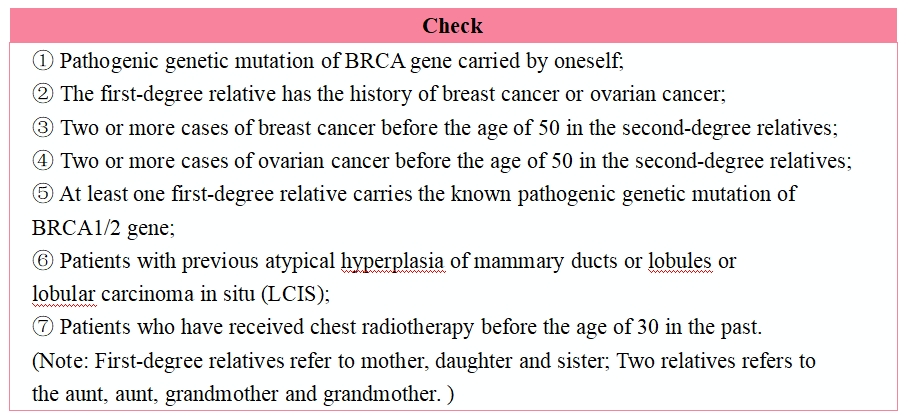
General risk population
It is recommended that the starting and ending age of screening be 40–70 years old. All women except those at high risk for breast cancer.
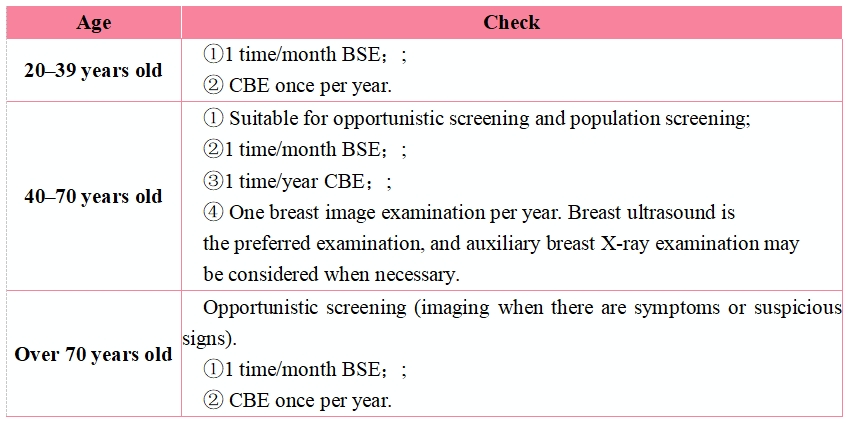
03. Screening methods [3–6]
At present, the common breast cancer screening methods in China include breast self-examination (BSE), clinical breast physical examination (CBE) and breast image examination, among which image examination includes breast ultrasound, breast X-ray (mammography) and breast magnetic resonance imaging (MRI). Breast ultrasound is the preferred method for female breast cancer screening in China recommended by consensus in most guidelines in China.
Breast self-examination (BSE)
1. Description
Women themselves undergo regular breast hand examinations.
2. Advantage
Is beneficial to improve female breast health and cancer prevention consciousness, and is low in cost, easy to operate and convenient for large-scale popularization and application.
3. Remarks
It is recommended that premenopausal women choose to conduct breast self-examination within 1 week after their menstruation, and postmenopausal women can choose a fixed date of each month to conduct breast self-examination.
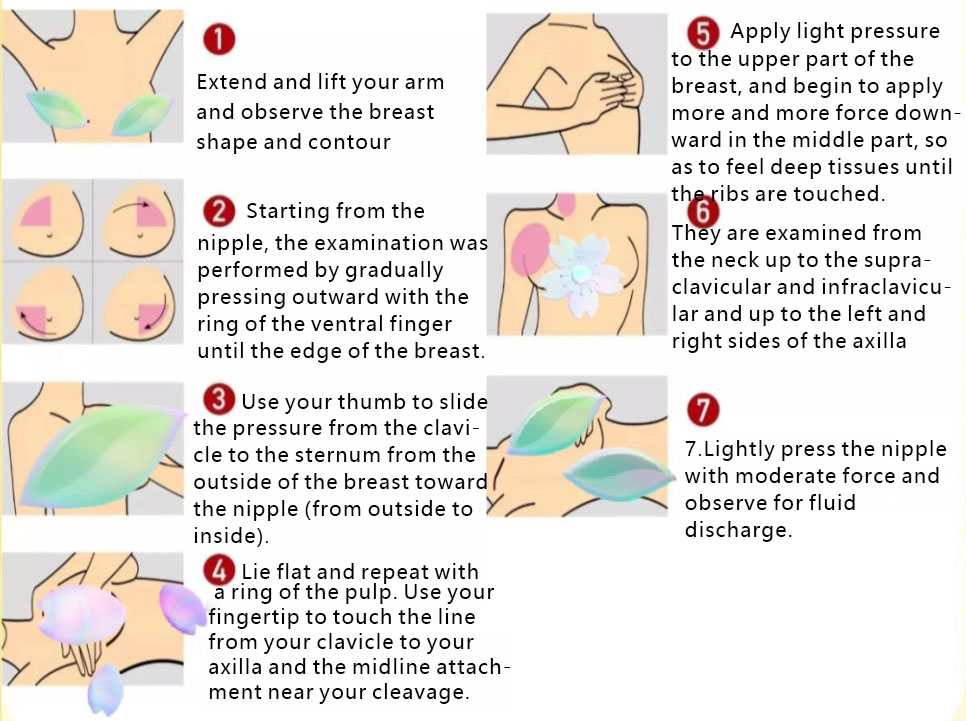
Clinical Breast Exam (CBE)
1. Description
Clinicians perform breast and axillary palpation in women.
2. Advantage
Compared with BSE, physical examinations performed by clinicians are more comprehensive, detailed and accurate. CBE is a low-cost and easy-to-conduct screening method in areas where health conditions and medical resources are scarce.
3. Remarks
Combined with ultrasound and X-ray examination can improve the detection rate of breast cancer and reduce the missed diagnosis rate. The quality of single screening is limited. It is recommended that premenopausal women choose within 1 week after the menstruation during the visit period.
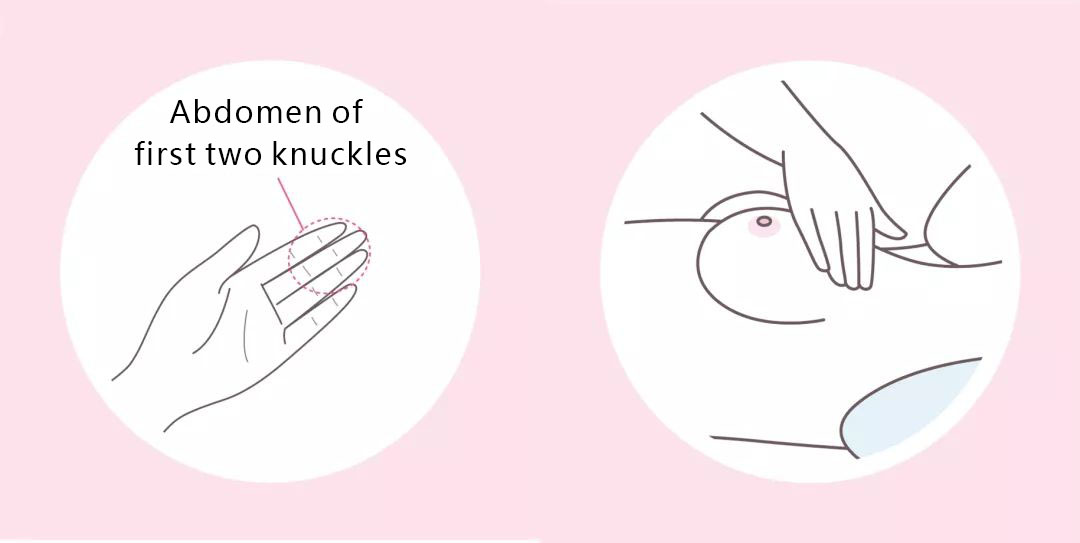
Breast ultrasound
1. Description
Ultrasound is recommended as the preferred method of breast cancer screening for women in China in the China Guidelines for Female Breast Cancer Screening (2022 Edition).
2. Advantage
Has the advantages of no trauma, no radiation, low cost, simple operation and the like.
3. remarks
At present, the main mode of breast cancer screening in China is due to the high proportion of women (about 49.2%) with dense breast. Inspection results are reported according to BI-RADS classification criteria (see Appendix).
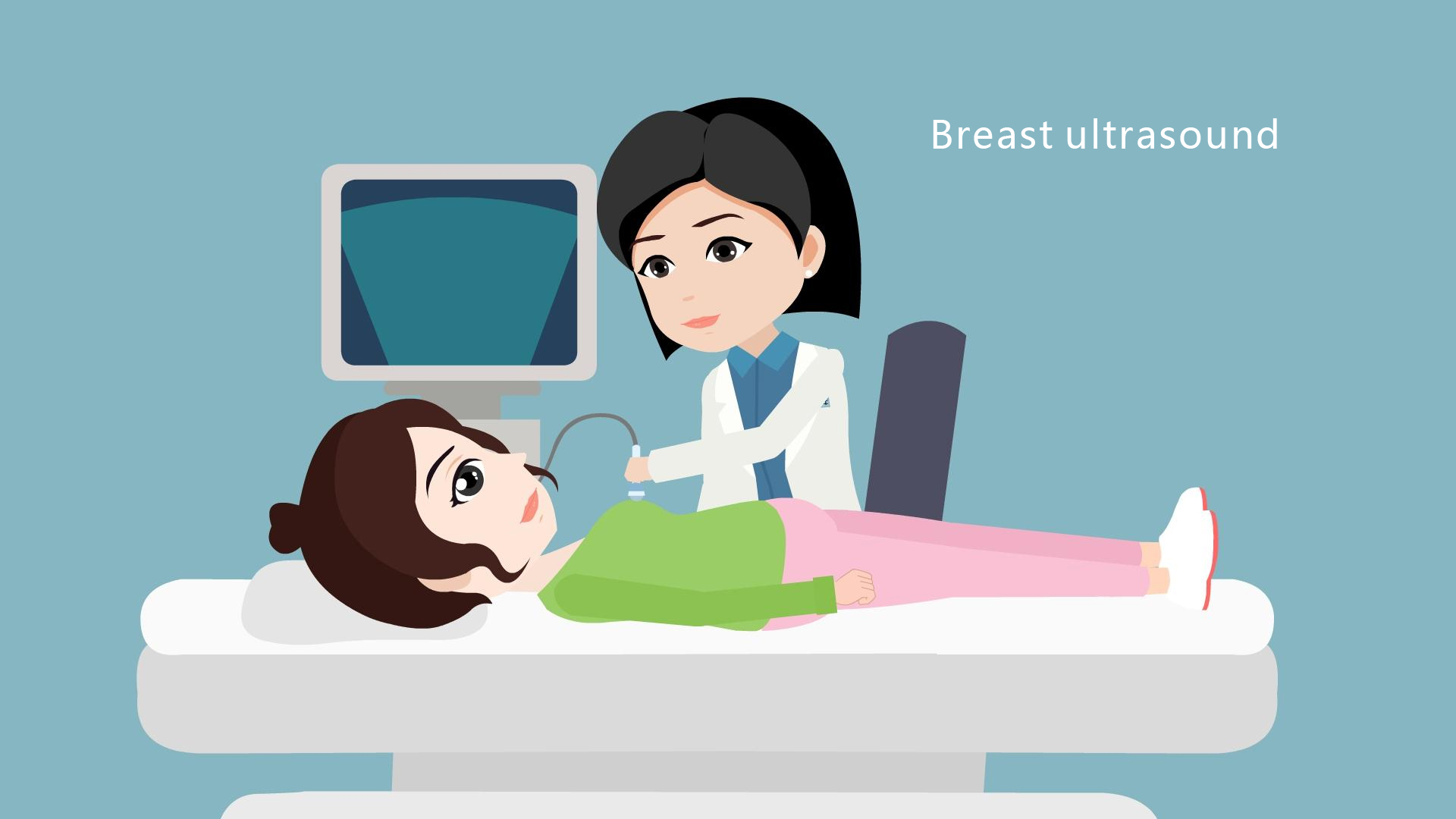
Mammography
1. Description
European countries are the main means for breast cancer screening, but their sensitivity and accuracy for dense breast are low.
2. Advantage
There are incomparable advantages in the detection of calcification with other imaging methods.
3. Remarks
There is a certain amount of radioactive damage (although the radiation dose is low) and young women (< 40 years of age) are not recommended to choose as the primary means of screening. Inspection results are reported according to BI-RADS classification criteria (see Appendix).

Magnetic resonance imaging (MRI) of the breast
1. Description
Not as a routine breast canc screening tool
2. Advantage
It has high sensitivity and can display multi-focus, multi-center or bilateral breast cancer foci, and simultaneously display the relationship between the tumor and chest wall, axillary lymph node metastasis and the like, thereby providing more reliable basis for formulating a surgical scheme.
3. Remarks
It is mainly used for breast ultrasound, supplementary X-ray examination and screening of high-risk population of gene mutation carriers (BRCA1, BRCA2, CDH1, PALB2, PTEN and TP53, etc.).
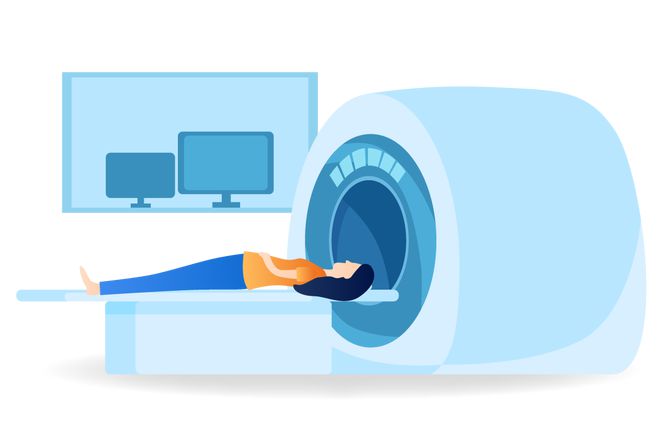
04. Screening recommendations for high-risk population [4]
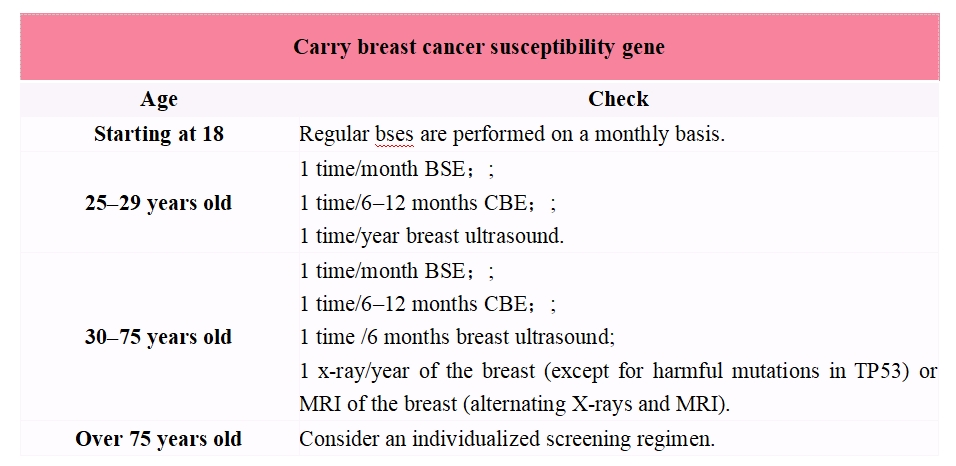
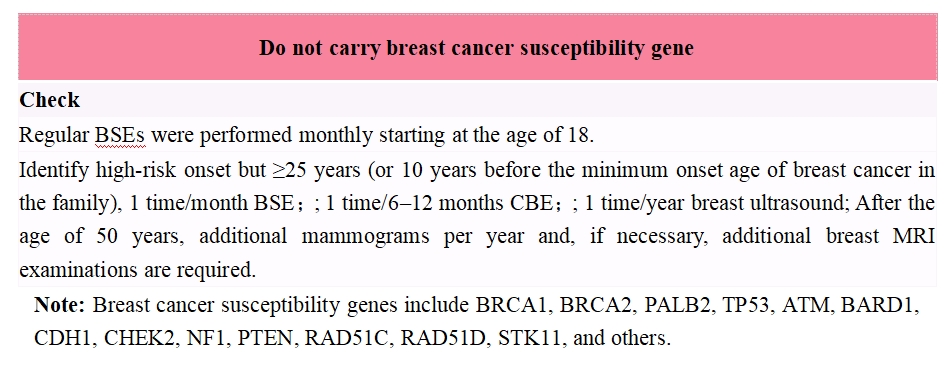
05. Appendix ——BI-RADS Classification Standard [6]
Current imaging (ultrasound, X-ray, and MRI) findings should be recorded and analyzed using the Breast Imaging Reporting and Data System (BI-RADS). Among them, those screened by BI-RADS who were classified into Category 3 needed to have their ultrasound re-examined after 6 months, and if it remained stable, they could continue to follow up. If the classification of the lesion increases (class 4, class 5), clinical intervention is required, including fine needle aspiration cytology or coarse needle aspiration biopsy or surgical resection biopsy to clarify the nature of the lesion.
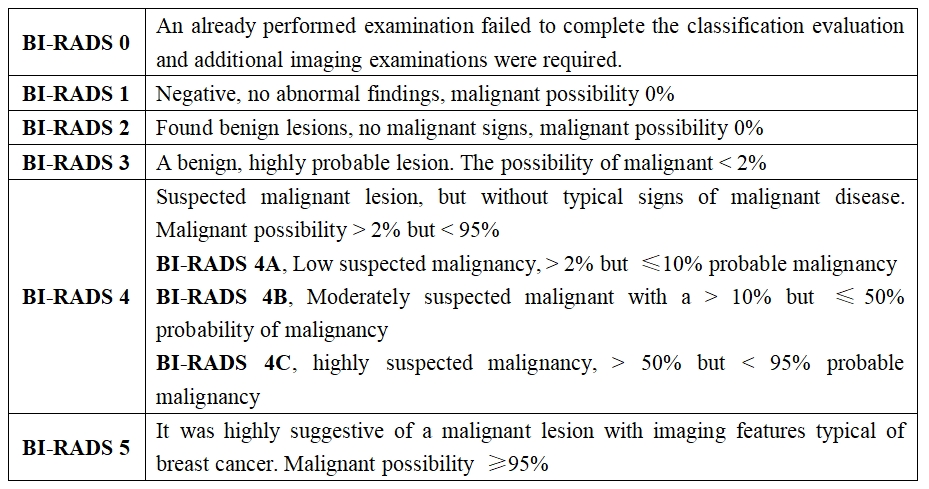
References
[1] Journal of the National Cancer Center,2024:47-53.
[2] JAMA,2015(15),314:1599-1614.
[3] Guidelines and specifications for diagnosis and treatment of breast cancer by China Association of Cancer Control (2024 edition)
[4] China female breast cancer screening guidelines (2022 edition)
[5] Breast cancer diagnosis and treatment guidelines (2022 edition)
[6] Expert consensus on standardized pathway for opportunistic screening for breast cancer
Statement:
This article is only for sharing, if it involves copyright issues, please contact us as soon as possible, we will correct the first time, thank you!